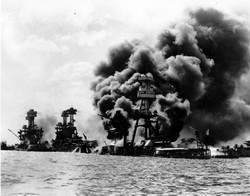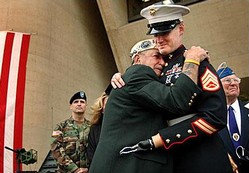
The weather that morning was beautiful over Pearl Harbor as one might expect in paradise. The USS Tennessee reported winds at 11 to 16 miles an hour and slight wind ripples on the water of the bay. The USS Oklahoma reported clear skies with “intermittent moving fleecy clouds.” Little did the men making those weather reports know that hell was about to rain down on them.
69 years ago today, the United States was forced into World War II with the brutal surprise attack on Pearl Harbor. Over 2,300 servicemen lost their lives on that fateful day, a “date which will live in infamy.” Relatively unknown in the stories of that fateful day is how the weather played a key and prominent role.
On December 4th, a Japanese intelligence officer at their embassy in Washington D.C. was listening to Radio Tokyo as he had been for the last two weeks. The weather report: “Higashi no kaze ame”, or “east wind, rain.” That seemingly innocent phrase was in actuality code to Japanese diplomats to destroy all of their cryptographic equipment, books and top secret documents as an attack was imminent. A weather report sounded the alarm that war was coming.
On Oahu, December and January are actually the cloudiest months and this was a concern for the Japanese in the planning of their attack. Timing was of the essence as winter in the Pacific can be brutal and if they were forced to wait till late December, success would be in doubt. The clouds would be good for hiding the planes on their approach to the islands but if they couldn’t see their targets, the attack could not be successful.
220 miles north of Oahu and heading east into a steady wind, the Japanese fleet launched its planes at 6:10am. The wind provided the extra lift for the bomb-laden planes and low clouds at 5,000 feet helped to provide cover for the fleet and its planes. The question remained however – would there be clouds over the target?
As the planes headed toward Pearl, U.S. code breakers intercepted a message from Tokyo to Japanese diplomats telling them to break off talks with the United States. At 7:33am, Army Chief of Staff, General George C. Marshall, believed this could be the harbinger of an attack and he sends a warning to Lt. Gen. Walter C. Short, commander of U.S. Army forces in Hawaii. Atmospheric static however prevents the message from being sent by radio and Marshall’s message is sent via commercial telegraph instead. Short’s headquarters receives the message at 11:45am and he did not see it until 3:00pm – more than eight hours after the attack had started.
Flying between 9,000 and 14,000 feet, the clouds provided the cover that the Japanese planes needed. Using a Honolulu radio station to guide them, the planes neared the north coast at 7:30am and heard the radio announcer report, “clouds, mostly over the mountains. Visibility good.” That is exactly what they wanted to hear. Their approach over the mountains of the island was concealed by the clouds and as they neared Pearl Harbor, those clear skies reported by the USS Oklahoma and Tennessee provided the bombers the visibility they needed to hit their targets. At 7:55am, metal rain began to fall on our soldiers, sailors and airmen.
Our nation was forever changed that day and as is often the case, the weather played a key role in this moment in history. After the attack, Japanese Admiral Isoroku Yamamoto said, “We have awakened a sleeping giant and have instilled in him a terrible resolve.” Indeed that was the case but the price was heavy as nearly 300,000 United States service members would lose their lives in the years to come.

On personal note, I ask all of our readers to take the time today to acknowledge and remember not only those that paid the ultimate sacrifice on December 7, 1941 and in the following years, but also remember that more than 16 million men and women served in the armed forces during World War II. Of those, a mere 2.3 million are still with us today and 1,000 World War II veterans die each and every day. As we mourn their passing, we should also remember that which they stood for – honor, sacrifice, courage, God and country. There had never been – and there never will be – a generation like theirs. I thank them for their service and hope they may have the peace in heaven that they did not see while on earth. God bless you all.
For more information: Please help Thornton build a memorial to honor not only World War II veterans but all veterans from all branches of service and all wars. The owner and operator of ThorntonWeather.com is a significant contributor to the project and asks that our visitors consider donating to the project. Please visit the Thornton Veterans Memorial website for more information.
